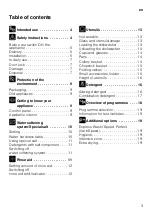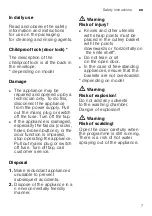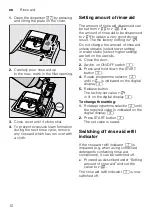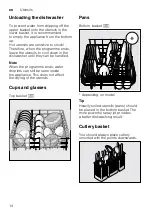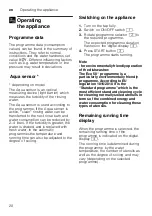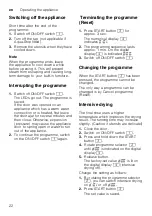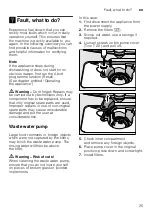
Utensils
en
13
-
Utensils
U
ten
sils
Not suitable
ヽ
Cutlery and utensils made of wood.
ヽ
Delicate decorative glasses, craft
and antique utensils. These decors
are not dishwasher-proof.
ヽ
Plastic parts not resistant to heat.
ヽ
Copper and tin utensils.
ヽ
Utensils which are soiled with ash,
wax, lubricating grease or ink.
Aluminium and silver parts have a
tendency to discolour and fade during
the wash cycle. Even some types of
glass (e.g. crystal glass objects) may
turn cloudy after many wash cycles.
Glass and utensil damage
Causes:
ヽ
Glass type and glass production
process.
ヽ
Chemical composition of the
detergent.
ヽ
Water temperature of the wash
programme.
Recommendation:
ヽ
Use only glasses and porcelain
which the manufacturer designates
as dishwasher-proof.
ヽ
Use a detergent which protects
utensils.
ヽ
Take glass and cutlery out of the
dishwasher as soon as possible after
the programme ends.
Loading the dishwasher
1.
Remove large food remnants. It is
not necessary to prerinse utensils
under running water.
2.
Place the utensils so that
– they are secure and cannot tip
over.
– all utensils with their openings
face down.
– parts with curves or indentations
are at an angle, thereby allowing
water to drain.
– does not obstruct rotation of the
two spray arms
1*
and
12
.
Very small utensils should not be
washed in the machine, as they may fall
out of the baskets.
Note
The spray arm for the top basket is
offset to the side to provide adequate
space in the bottom basket for large
plates, bowls or pots. If only closed
receptacles such as bowls or pots are
placed on the right in the bottom
basket, tall utensils, e.g. tall glasses,
situated on the right in the top basket
may not receive adequate water. In this
case place only short utensils on the
right in the top basket and tall ones
on the left.
Summary of Contents for SC73E610TI
Page 2: ...6WDUW 5HVHW VHF ...



